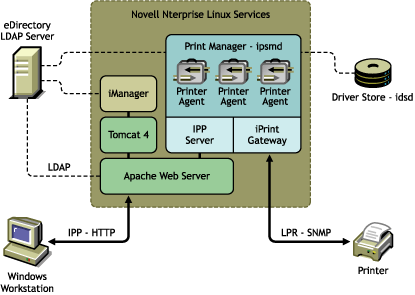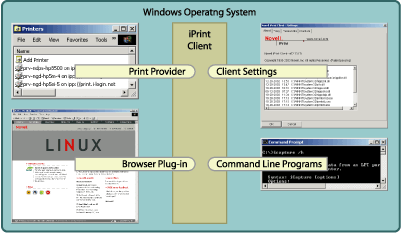iPrint Component Overview

iPrint consists of three main components: the iPrint Manager, the iPrint Driver Store, and the iPrint Client.
Figure 2
iPrint Component Overview
The iPrint Manager is an object in the eDirectory tree as well as software that runs on your Linux server. Print jobs are submitted to the iPrint Manager and then forwarded to the printer, when the printer is ready.
Figure 3
Print Job Flow through the iPrint Manager
A single iPrint Manager can handle print jobs for multiple printers. Depending on your network configuration (for example, remote locations) you can create additional iPrint Managers on other servers, but only one iPrint Manager can exist on the any one server. Using access control, the iPrint Manager allows authorized users to print.
Printer Agent: The Printer Agent is an entry in the iPrint Manager database that represents the printer. The Printer Agent is automatically created in the database when you create a Printer object in eDirectory. The Printer Agent manages the processing of print jobs, answers queries from network clients about a print job or attributes of a printer, and generates event notification so that interested parties can be notified of printing problems and errors or changes in the status of a print job, document, or printer.
IPP server: The IPP server's main function is to handle IPP and IPPS requests from the Web server and deliver the requests to the iPrint Manager or to the iPrint Driver Store.
iPrint Gateway: The gateway maintains communication with the printers and forwards print jobs from the Print Manager to the printer using LPR over the TCP/IP protocol. Using SNMP, the gateway queries printers to get their status and other printer information.
The iPrint Driver Store is a repository of printer drivers for your print system. When the first user of a printer installs that printer, the iPrint Manager requests the assoicated printer driver from the iPrint Driver Store and caches the printer driver for future uses. Periodically, iPrint Managers refresh their cached copies of printer drivers for the printers they are hosting with updated printer drivers from their associated Driver Store.
The iPrint Driver Store is an eDirectory object. Only one iPrint Driver Store is required on a network but, depending on your network configuration, you can create additional iPrint Driver Stores. The fewer Driver Stores running, the better because you will not have to track which Driver Store has which printer drivers.
The iPrint Client is comprised of a print provider, browser plug-in, client configuration options, and command line utilities.
Figure 4
iPrint Client components
Print Provider: The iPrint Print Provider communicates directly with the Windows Spooler, which takes print jobs from applications and delivers them to a print provider. Upon start up, the iPrint Client ensures that the iPrint Print Provider is the first one in the list of providers. When a print job is destined for an iPrint printer, the iPrint Print Provider delivers the print job to the iPrint Manager.
Browser plug-in: The iPrint Client contains a browser plug-in for Internet Explorer. This OCX-based plug-in lets you install printers through your Web browser.
Client configuration: Through the iPrint Client configuration screen, you can take advantage of several advanced client features. For more information on each of these features, see the associated documentation. These features include the following:
Command line utilities: The iPrint MS-DOS commands let you install iPrint printers without a Web browser and capture LPT ports to iPrint printers. These commands are useful when you have legacy applications that require output to an LPT port, or when you want to add printers through a login script.
For more information, see Implementing iPrint Using MS-DOS Commands.
Apache 2.0 is the Web server for iPrint. The Web server serves up HTML pages, handles secure (SSL) and nonsecure requests, and utilizes LDAP for authentication.
To manage iPrint, use Novell iManager. For more information, see the specific iPrint task or the Novell iManager 2.0.x Administration Guide.